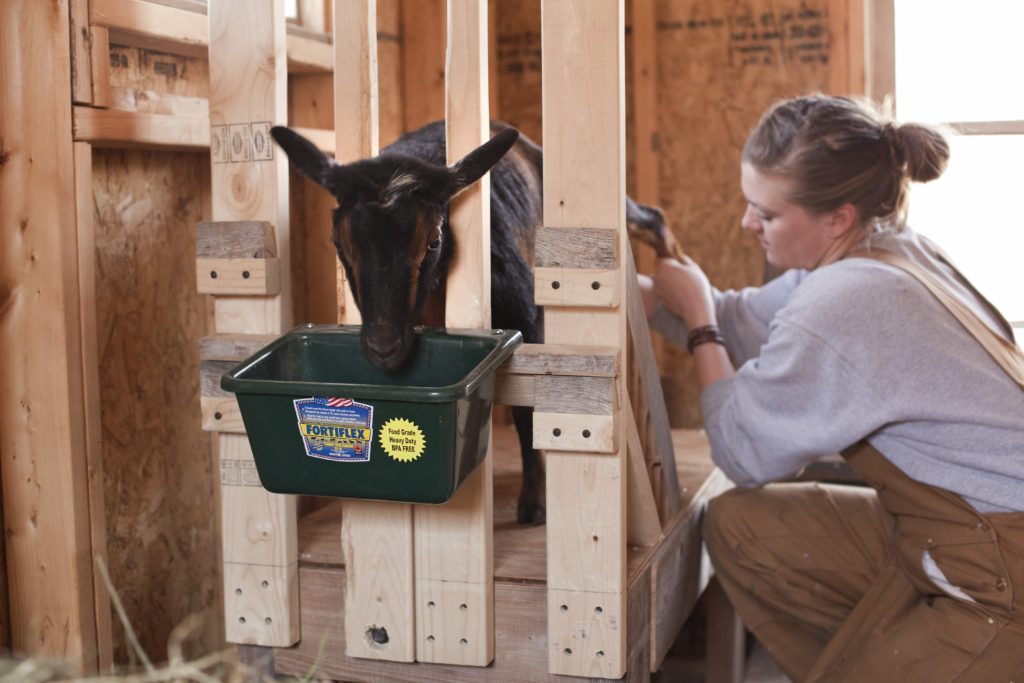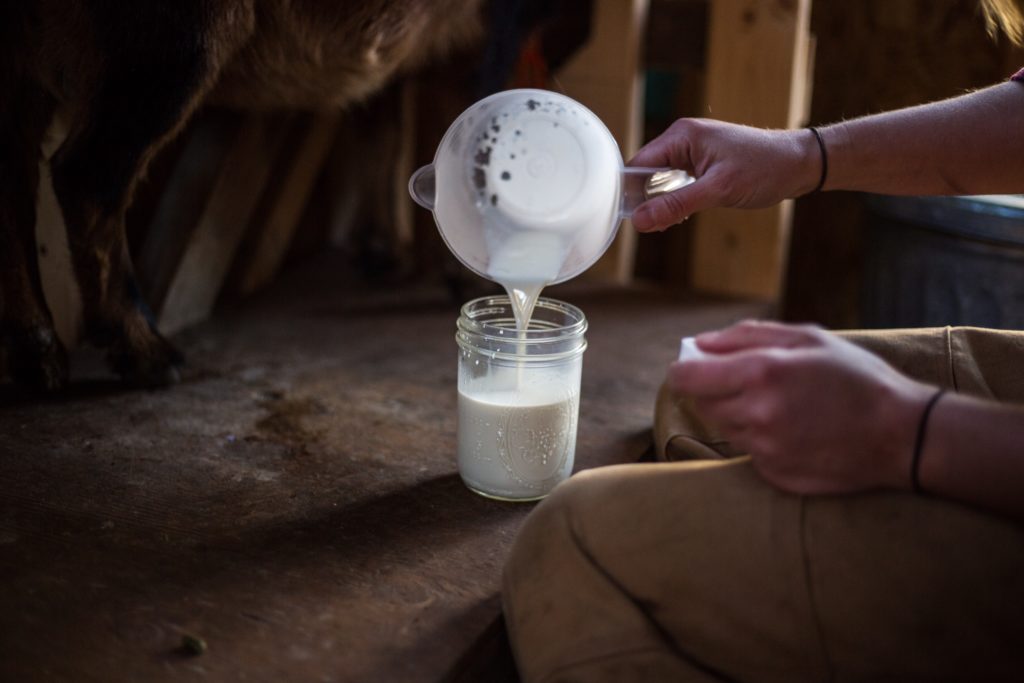Last spring my dream of having my own dairy goat in milk came true. I welcomed home Audrey, a second freshener Nigerian Dwarf who sadly lost her kids at birth. I milked Audrey at my friend Angelas the night I brought her home and she was a dream on the stand. She would give the occassional foot stomp, but that was it! She stood like a champ and quietly munched on her grain while I emptied her udder full of creamy milk.
I brought her home afterwards and was already looking forward to waking up the next morning to head down to my own barn, bucket in tow and milk her on my stand. Well, morning came, the bucket was in tow, and what ensued was total chaos! Bronco bucking, kicking, handstands, at one point she actually sat down! Who was this goat and what did she do with Audrey?! I couldn’t even touch her. I was frustrated to the point of crying and didn’t understand what was wrong with her and why this was happening to me. I called the woman who lives up the street from me and asked her to come down to help me and hold her legs. It was ugly and stressful, certainly not the romanticized vision I had in my head. But, we got the job done. That night she came to help again, and then only a mere two days later I was milking her solo without issue. So, how did I get to that point?
Looking back it was pretty naive of me to think that I would be able to bring home a three year old doe who had just left her home, put her with a new herd, on a new milk stand with a new person milking and think that it would be easy. Duh. I knew she would have to adjust, but I definitely underestimated it. Live and learn! Through my experience there are some things that I learned I will keep in my back pocket, because this surely won’t be the last time this will happen. I am by no means an expert on the topic, but I can certainly give some pointers that worked for me and if you’re in a similar situation, will hopefully work for you!
Patience of a Saint
There is no way I can possible stress this point enough. You need the patience of a saint. Goats are incredibly intelligent and intuitive animals and they can sense when you’re stressed. If you’re stressed and/or frustrated with her, you’ll only transmit that negative energy to her. Initially give yourself plenty of time to milk. Depending on if you’re an experienced milker or not, it may take you twenty to thirty minutes to actually milk her out. So give yourself forty five minutes or so to account for her acting up, and taking things slow. Whether this means you have to wake up earlier, or take a shower at night rather than the morning, do it because if you’re rushed you’ll be impatient. I am so grateful I picked her up right before the weekend, so I could really take my time and not be worried about running into issues and being late for work.

Associate the Milk Stand with a Pleasant Experience
It is crucial at first for her to associate the milk stand with a good experience. Otherwise, she won’t want to go on willingly, and when you do muscle her up you’ll be fighting her the whole time she is up there. I like to set the mood before even putting her on the stand. I play calm classical music when I first get in the barn and let her out of the stall to mosey around. Eventually she makes her way over to the stand and hops up for grain. When you first get her on the stand you don’t want to jump right into the milking. Pet her, brush her, clean her udder then pet her some more while she is eating. Then start milking while speaking softly and telling her what a good girl she is. Take breaks if she starts kicking or bucking, then start again when she’s calmed down. Going slow and not rushing the process is key initially. You need to be firm and show her who is boss when she tests you, but stay calm and collected. And always make sure you end on a good note!
Lift a Leg to Milk
If you take anything away from this post, make it this. Milk with a leg up. Not only does this give you easier access to the teat, but it really keeps her from kicking. They make hobbles, but think about it: both legs are still down on the stand. Even though they’re connected, she can still launch her back legs up and hop like a bunny. If you hold a leg up, she is trying to stabilize herself and keep balance with that one leg making it way more difficult for her to hop around. Now she still may, but it’s more of a short hop rather than a full on kick. It’s much more manageable, and a heck of a lot easier to milk rather than trying to tame a two legged bucking doe! Because Audrey has a young and tight udder, this will be how I milk her normally because it gives me free and clear access to her teat without her leg getting in the way. When I dump the milk, I put her leg down to give her a break and then lift it again when I’m ready.
Frequently Dump the Milk
Now this tip is more for you than for her. Always have another container away from the stand to dump your milk into and do it frequently. It’s inevitable you will get a foot in your bucket/jar/measuring cup at some point, so it’s better that you dump it regularly so if/when it happens you don’t have to throw away half of your day’s milk. Because when it does happen (and the likelihood of it happening is certainly higher with a kicking and jumping doe) you will be mad, and it will only frustrate you further making the situation worse.

Lavender Essential Oil
This one I didn’t personally try because I literally ran out of lavender essential when I had brought her home. But, I strongly suspect that it would work, and if not it certainly won’t hurt! Pure lavender essential oil is renowned for its calming and soothing effects. So, if you dab a couple drops around her collar before putting her on the stand it, or even put it in a diffuser it will allow her to breathe it in and (hopefully) calm her down and put her at ease.
By living by all these tips I went from being in tears that first morning not knowing how I was going to make this work, to essentially stress free milking and singing happily by the end of the weekend. If you are having the same struggle, it is going to take time and patience. There are no shortcuts, but there are things you can do to help. How much time depends on the goat, and if she has ever been milked before or is a first freshener. Have you ever milked a stubborn goat? What worked for you to help tame her?



Great story and right on target
Definitely planning on trying the leg-up trick tomorrow morning. My first time freshener Fatty Mayonnaise is giving me a rough time on the stand, but with her 4 kids sold and gone, she has to let go of some of that milk!
Oh Fatty!!!! I hope she gives you some delicious fatty milk 🙂 Goodluck!
Pingback: Goat's Milk Mozzarella - The Modern Day Settler